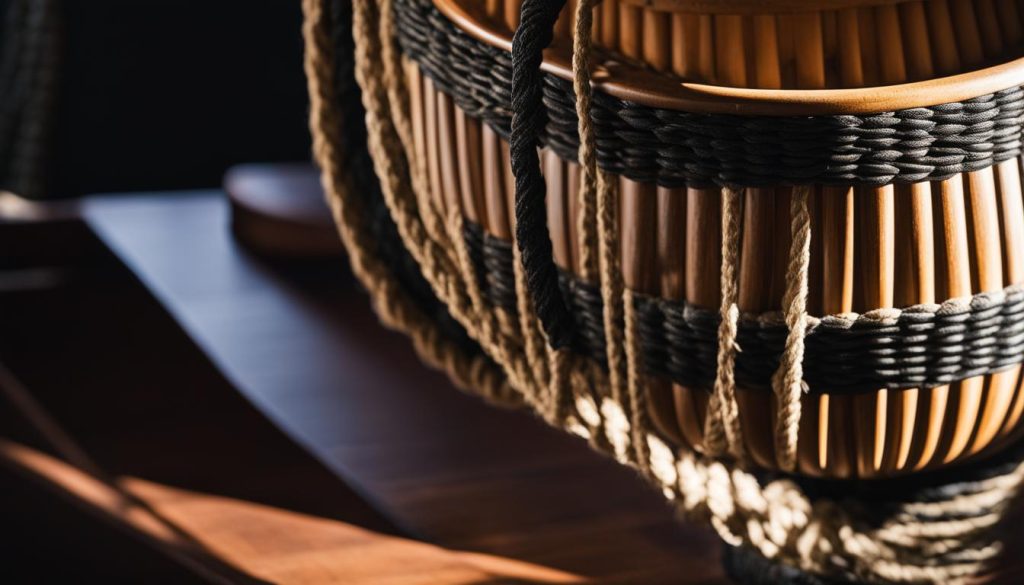Tuning a djembe is an essential skill for any drummer. Whether you are a professional, amateur, or hobbyist, knowing how to tune your djembe will ensure you achieve the perfect sound and keep your drum in top form.
How to tune a djembe and the process can vary depending on the type of drum and the desired sound, but with the right techniques and tools, you can easily tune your djembe to produce crisp tones and a clear, consistent sound across the entire drumhead.
In this comprehensive guide, we will explore different djembe tuning techniques, step-by-step instructions to tune your djembe, tips for maintaining the perfect sound, and essential tools for professional djembe tuning.
Whether you are a beginner or an experienced drummer, mastering the art of djembe drum tuning will enhance your musical expression and take your drumming technique to the next level.

Content
Understanding Djembe Tuning: Key-Tuned vs. Rope-Tuned Djembes
When it comes to tuning a djembe, it’s important to understand the key differences between key-tuned and rope-tuned djembe.
Each type of drum requires specific tuning techniques and tools to achieve the desired sound quality.
Let’s explore the characteristics and tuning methods for both key-tuned and rope-tuned djembes.
Key-Tuned Djembes
Key-tuned djembes are equipped with hardware that is fixed to the base of the drum, allowing for easy tension adjustment.
This hardware typically consists of metal lugs and a rim that encloses the drumhead. With the help of a drum key or wrench, you can tighten or loosen the lugs to adjust the tension and, consequently, the sound of the drum.
When tuning a key-tuned djembe, it’s crucial to tighten each lug slightly in a clockwise or counter-clockwise direction.
This ensures that the tension is evenly distributed across the drumhead, resulting in a consistent sound quality. By making small adjustments to the tension of each lug, you can control the overall tone and projection of the djembe.
Rope-Tuned Djembes
Rope-tuned djembes have a more traditional construction, with the drumhead attached to the base using metal rings and vertically woven ropes.
Tuning a rope-tuned djembe requires more time and skill compared to key-tuned drums.
The tuning process for a rope-tuned djembe involves the use of the Mali weave technique. Additional ropes are woven through the vertical lines on the drumhead and knotted to create diamond patterns.
This technique allows for greater control over the tension and allows the drum to accommodate any variations in the drumhead and wood base.
By adjusting the tension of the ropes using knots, you can fine-tune the drumhead to achieve the desired sound.
The Mali weave technique provides flexibility and allows for precise sound control, making rope-tuned djembes popular among professional drummers and those seeking a traditional sound.

Understanding the differences between key-tuned and rope-tuned djembes is essential for tuning your drum effectively.
Whether you opt for the convenience of key-tuned hardware or the traditional construction of a rope-tuned djembe, mastering the tuning process will allow you to unlock the full potential of your drum and achieve the desired sound control.
Step-by-Step Guide on How To Tune Djembe
When it comes to tuning a djembe, it’s important to follow a systematic approach to achieve the ideal sound.
By understanding the drum tightening process and making necessary adjustments, you can ensure the best skin tension and overall drum quality.
Determining Tuning Needs
Before starting the tuning process, it’s essential to assess the drum’s current condition and determine its tuning needs.
This can be done by testing the tightness of the drum skin. Gently tap the drumhead with your fingers or a stick and assess the pitch and resonance. If the sound is inconsistent or lacks clarity, it may be an indication that the drum needs tuning.
Tuning Tools
To tune a djembe, you’ll need a few essential tools. For minor tuning adjustments, a short stick or broomstick can be used to tighten or loosen the ropes. In cases where major adjustments are required, pliers can be used to enhance drum skin tightness and achieve the desired sound.
Additionally, specialized tuning tools such as a clam cleat puller or rope puller toolset can assist in achieving precise tensioning.
The Mali Weave Technique
For rope-tuned djembes, the Mali weave technique is crucial for proper tuning. To begin, establish the desired tension by tightening or loosening the vertical ropes evenly.
Undoing the Mali weave and reweaving the vertical ropes using the diamond pattern technique will help achieve the desired tightness and tension across the entire drumhead.
Understanding the Bass Note
When tuning a djembe, understanding the bass note is vital for achieving the ideal sound.
The bass note is produced by the center of the drumhead, and its pitch can be adjusted by tightening or loosening the ropes in that area. Experiment with different tension adjustments to find the optimal bass note that suits your preferences.
Tuning Adjustments and Skin Thickness
Another essential consideration when tuning a djembe is the drum skin’s thickness. Thicker skins generally require more tension to produce a desired sound, while thinner skins may require less.
Experiment with different tension adjustments based on the skin thickness to achieve the desired tone and response from the drumhead.
A thorough understanding of these tuning techniques and adjustments will enable you to master the art of tuning a djembe and achieve the perfect sound that resonates with your musical expression.
| Tuning Tips | Tuning Tools |
|---|---|
| – Test the tightness of the drum skin to determine tuning needs | – Short stick or broomstick |
| – Use pliers for major tuning adjustments | – Pliers |
| – Employ specialized tools such as clam cleat puller or rope puller toolset for precise tensioning | – Clam cleat puller or rope puller toolset |
| – Follow the Mali weave technique for rope-tuned djembes | |
| – Understand the bass note and make appropriate tension adjustments | |
| – Consider the drum skin’s thickness when making tuning adjustments |
Maintaining the Perfect Djembe Sound
In addition to tuning, maintaining the perfect sound of your djembe requires proper care and attention.
Djembes are vulnerable to various weather conditions and handling problems, so it is important to store and transport your drum safely.
Regular maintenance and tuning can prolong the life of your drum and ensure it lasts through performances, drum circles, and solo playing. By keeping your djembe in good condition, you can preserve the quality of its sound for years to come.
Drumhead Care
One key aspect of djembe maintenance is taking care of the drumhead. The drumhead is responsible for producing the distinct sound of the djembe, and it is important to keep it in optimal condition.
Here are some tips for drumhead care:
- Keep the drumhead clean by wiping off any dirt or sweat after each use.
- Avoid exposing the drumhead to extreme temperature changes, as this can cause it to tighten or loosen.
- Use a drumhead conditioner or oil to keep the drumhead moisturized and prevent it from drying out.
- Inspect the drumhead regularly for any signs of wear or damage. If there are any tears or holes, consider replacing the drumhead.
Storage and Transportation
Proper storage and transportation are crucial for maintaining the integrity of your djembe. Whether you’re storing it at home or taking it to a gig, follow these guidelines:
- Choose a dry and cool environment for storing your djembe to prevent moisture damage.
- Avoid placing heavy objects on top of the drum, as this can deform the shape and affect the sound quality.
- When transporting your djembe, use a padded case or bag to protect it from bumps and scratches.
- If you’re traveling by plane, consider loosening the drumhead tension to prevent excessive pressure changes.
Drum Longevity and Performance
Regular maintenance and proper care can significantly extend the lifespan of your djembe while ensuring optimal performance.
Here are some additional tips for preserving your drum’s longevity and enhancing its performance:
- Avoid exposing your djembe to direct sunlight for prolonged periods, as this can cause the wood to crack or fade.
- Protect the drum from extreme humidity or dryness, as it can affect the tension of the drumhead and the structural integrity of the drum.
- When playing in drum circles, be mindful of the impact your drumming technique has on the drum. Avoid excessive force that may lead to damage or unnecessary wear.
- Experiment with different playing styles and techniques to explore the full range of sounds your djembe can produce.
| Condition | Maintenance Actions |
|---|---|
| Dirty drumhead | Clean the drumhead using a soft cloth and mild soap. Avoid using harsh chemicals that may damage the drumhead. |
| Loose drumhead | Use a drumhead tightening tool to adjust the tension of the drumhead. Follow the manufacturer’s instructions for the specific tool you’re using. |
| Cracked wood base | Fill the cracks with wood filler and sand it down to smooth the surface. Apply a protective finish to prevent further damage. |
| Worn ropes or rings | Replace the worn ropes or rings with new ones. Make sure to use high-quality materials to maintain the integrity of the drum. |
Conclusion
Tuning a djembe is an essential skill that allows you, as a drummer, to achieve the perfect sound and fully express yourself through your drumming technique.
By understanding the different tuning techniques for key-tuned and rope-tuned djembes, and following a step-by-step guide, you can easily tune your djembe to produce crisp tones and a clear, consistent sound.
In mastering the art of djembe drum tuning, you can unlock the full potential of musical expression.
A well-tuned djembe allows you to explore various rhythms and styles, enhancing your drumming technique and captivating audiences with the vibrant and powerful sound that the djembe is known for.
